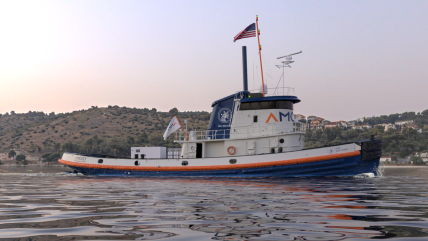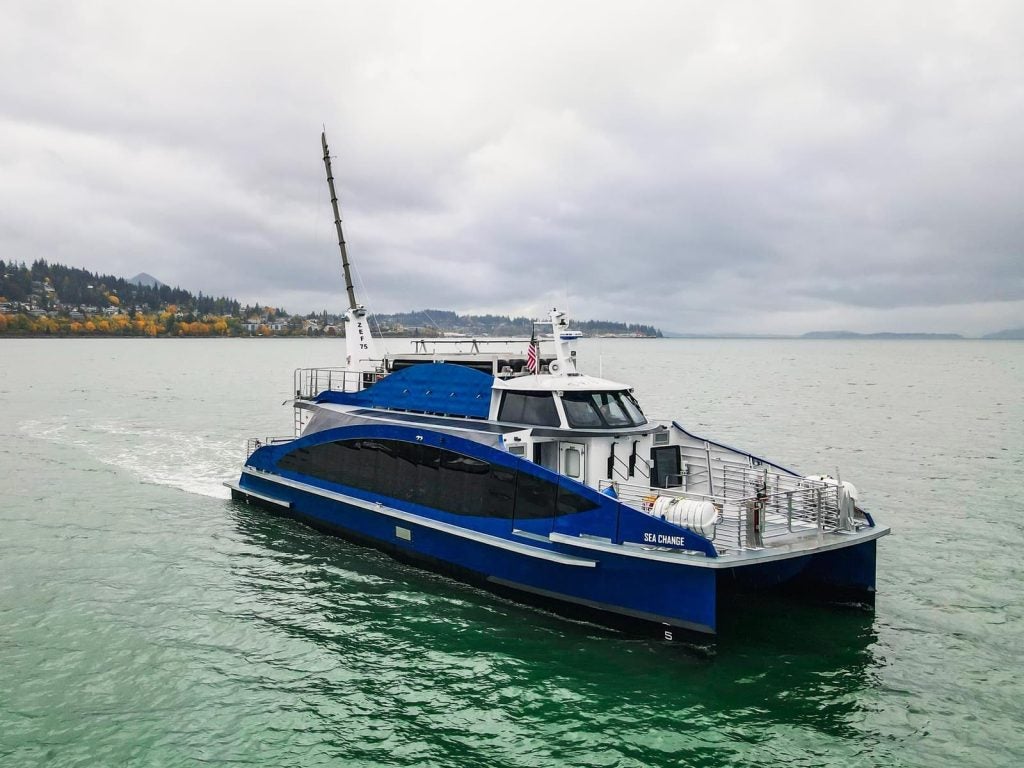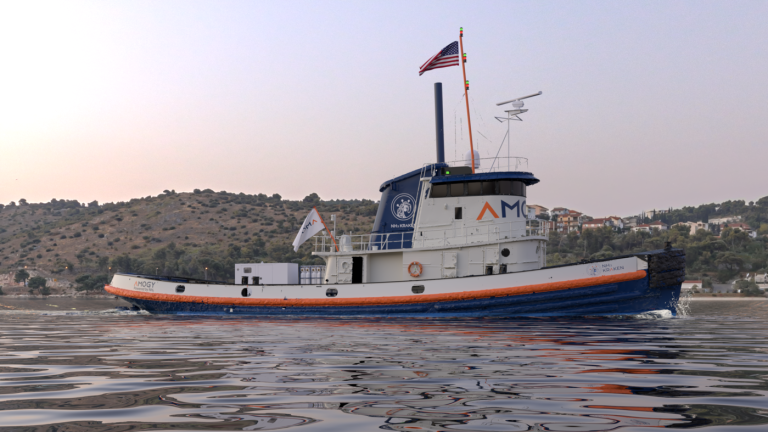
Decarbonising the marine industry has become a focal point for many of its largest companies, with significant investments made to reach net zero targets through more efficient technologies and sustainable fuels.
However, while some of these fuels – such as liquefied natural gas (LNG) and methanol – are already being used on ships as low-emission alternatives to traditional marine fuels, they both have drawbacks and impact the environment in different ways.
Electric motors have also gained popularity in recent decades, but have largely been transferred to smaller ships because of the difficulty in getting them to generate the kind of power needed for commercial cargo ships.
It is no surprise then that many companies continue to develop alternative energy sources for the industry, looking at fuels such as hydrogen, ammonia and even nuclear power.
One such company is Amoji, which hopes its ammonia-based technology will play a role in the future of the maritime sector. Anastasia Kupriyanova, Marine Business Development Manager, explains more about the development of ammonia fuel and the role Amoji can play in a more sustainable shipping industry.

Noah Povenizer: What makes Amoji stand out in the alternative fuel space?
Anastasia Kupriyanova: What we do is develop ammonia energy solutions, so we have a proprietary ammonia cracking solution with direct fuel cell integration that allows distributed power generation and a zero-carbon energy source mostly targeting applications in the marine sector.
Access the most comprehensive company profiles on the market, powered by GlobalData. Save hours of searching. Gain a competitive advantage.

Company profile – free sample
Your download email will arrive shortly
We are confident in the unique quality of our company profiles. However, we want you to make the decision that is most beneficial to your business, so we are offering a free sample that you can download by submitting the form below
By GlobalData
So you can really think that the core of our intellectual property is the chemical processing before the molecule enters the fuel cell.
One of the things that makes us more competitive in the market, and somewhat revolutionary in this area, is the high-efficiency catalyst that we develop in-house.
This catalyst is key to our reactor and the ability to “crack” ammonia at lower temperatures than conventionally available crackers currently on the market, thus also allowing our solution to be much smaller than those crackers on the market.
Note: Can you explain the company's main product and how it works?
And the: The Amogy Power Pack is a complete two-module ammonia power solution, with about 40% of the total footprint of the power pack made up of the fuel cell itself.
The remaining 60% is the “secret sauce” of ammonia in a lot of our science, so that ammonia is broken down in the referral stream, the referral stream is cleaned so that there are no trace amounts of ammonia left – as ammonia would damage the fuel cell – and then special adjustments are made on low temperature fuel cells to make them compatible with that reference current, hence a clean source of power.
This is a technology that we have proven and proven many times, and each time we scale the technology across the technology readiness scale. Our first demo was early in the creation of our organization, and it was on a 5 kilowatt scale using a drone that we flew here in Connecticut. We scaled the technology 20-fold to a tractor, and then in January of 2023, to a 200-kilowatt Class 8 truck.
This is technology that we have proven and proven many times.
This was our final pilot project, until we embarked on what has now become our final pilot project, directly into our primary target market with the marine industry. This is a 1MW scale tugboat conversion using our technology, a modernization currently underway at the Phoenix Shipyard in Kingston, New York.
This will be our last and final pilot project, showcasing our technology in this live marine application and allowing us to bring to market the first ammonia-powered vessel, in the water.
PS: You've had a successful career in the marine industry, what attracted you to Amogy in particular?
And: Over the past decade or so, I have developed a great passion for alternative propulsion and renewable technologies in the marine sector.
Unfortunately, I believe that unless there are people like us working in the maritime sector, the ordinary public does not realize how important maritime transport is to all industries and our global supply chain. Beyond just transporting goods, our waterways are also essential for transportation in general.
I first started my career focusing on the transportation part, so there was a lot of work in the public and private sectors, and a lot of P3 agreements for public ferry services. Through this, I have had the opportunity to work on a number of different renewable alternative propulsion projects, including electric and hybrid electric vessels.
I had the opportunity to work alongside the Hornblower team working as a systems integrator and owner's representative for a company Sea changeIt is the first hydrogen-powered ship to be launched locally [in the US]Through that experience, I saw first-hand that batteries can only take you so far. A fully electric vessel is usually a purpose built vessel, it operates on one specific route and this relates to its range.

Unfortunately, hydrogen and fuel cells are similar to that, so I was able to see first-hand the lack of a supply chain for hydrogen, the cost of hydrogen, and the difficulty of storing hydrogen. All of these factors combined don't make it a very acceptable solution for an industry that relies on on-time performance and reliability.
So when I first learned about ammonia as a potential hydrogen carrier, it was interesting and interesting to me. Especially since ammonia is a molecule that we as a society already know we treat as cargo, is readily available in over 200 ports around the world, and is transported through our waterways as cargo.
I wanted to look at the ability to unlock its potential, leverage some of the supply chain that's already in place, and also capitalize on the imagination of a lot of the development that's happening in green ammonia production.
Note: Is ammonia the only way forward for the marine industry? What are some of the strengths and weaknesses of other fuels?
And the: Right now, the maritime industry is experiencing a fundamental energy transition, which is very exciting but also brings with it a number of different solutions. My personal opinion is that there will not be a one-size-fits-all fuel in the future to support the marine industry.
It will be a mix of future fuels and alternative propulsion solutions, each best suited and most targeted to different types of ships, depending on their range, operational profile, ship size and the geography they operate in – and making sure they have the supply chain there.
All of these fuels have their own benefits, and in other ways have some challenges that they pose during their adoption in the marine field. We know for a fact that batteries will continue to play a prominent role, as batteries are a critical component of much of the adoption of these future fuels, and in fact, batteries are something that an emoji system requires as well.
There will not be a one-size-fits-all fuel in the future to support the marine industry.
Methanol offers an interesting solution as well, as it is a fuel that can be integrated into a standard two- or four-stroke engine, making the adoption process somewhat faster than some of these additional new systems. Although methanol is also energy dense, it is not as energy dense as diesel or ammonia, which is why a lot of these challenges present themselves.
But methanol is a carbon-based fuel, so you have carbon dioxide2 emissions, you'll still need a scrubber, you'll still need other aspects of decarbonization solutions on board your vessel to meet some of these very stringent regulations and targets that people are setting.
LNG will also continue to play a role, as will other biofuels, and there are more renewable energies quickly making their way into these talks as well, including nuclear and wind.
But to take a step back and sum up all of these thought processes, if you look at the publications of the three major classification societies over the last year or so and their forecasts for future fuels, they define it in two parts: the methanol path and the methanol path. Ammonia pathway.
PS: What is the timeline for Amogy's journey towards commercial sales?
And:The tugboat is our last and final demonstration project, and we are looking forward to putting her to sea, with this modernization process actively underway now. We will be able to use this project to collect a lot of data and hopefully also pave the way for regulation [approval]which is crucial when you're talking about new technologies and new future fuels.
After this pilot project, at the end of 2024 and early 2025, Amogy's focus will be on deploying pilot projects. This means deploying our technologies in the maritime sector for pilot projects with customers and key stakeholders.
Then, in mid-2025, our technology will be fully commercialized and available. Pre-sales are already underway, so there is an option for shipowners, operators and various other stakeholders to be able to get a place in line and secure the Amogy Power Pack, as well as the opportunity for a potential pilot project if it's a bit of an early adopter.


